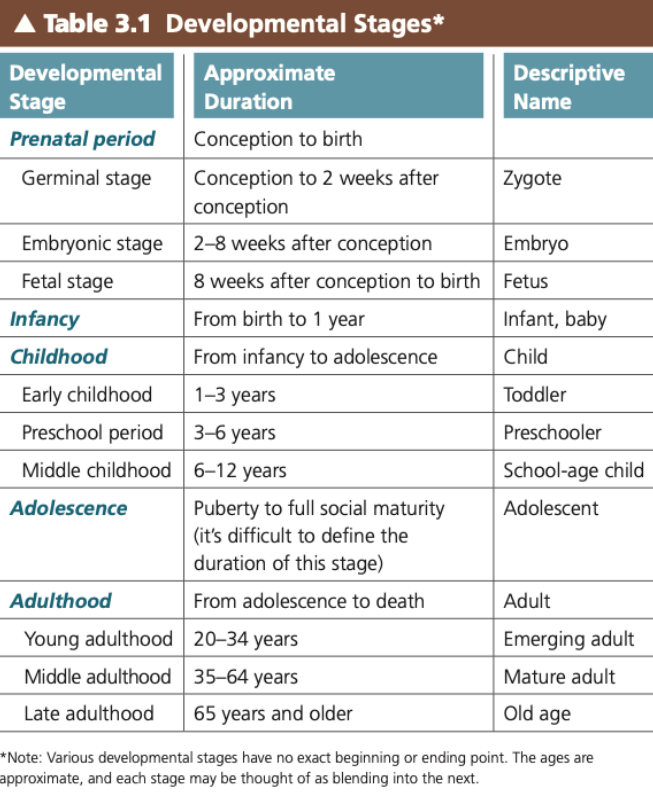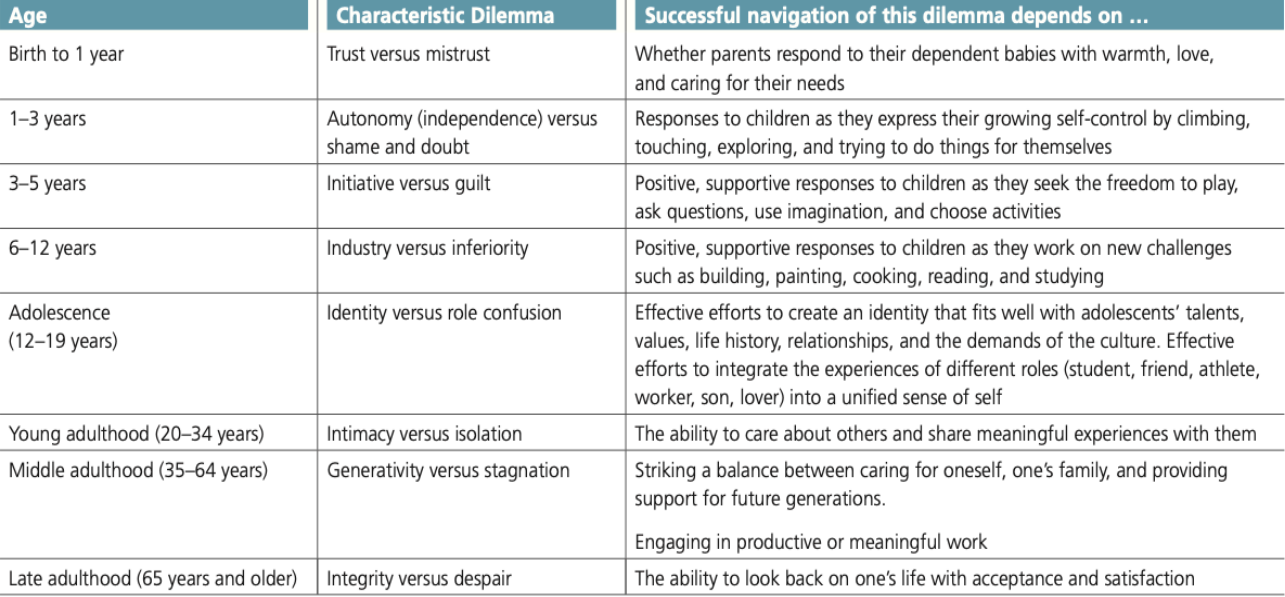Human Development
Definition (#f7aeae)
Important (#edcae9)
Extra (#fffe9d)
KEY CONCEPTS:
Nature vs nurture.
Physical development.
Social development.
Psychosocial theory.
Cognitive development.
Moral development.
Later adulthood & grief.
DEVELOPMENTAL PSYCHOLOGY:
Study of normal changes in behavior that occur across the life-span.
Shaped by a continuous interaction between hereditary (nature) and environment (nurture).
Examines how thinking, feeling and behavior evolve throughout life, from childhood to adulthood.
Helps to understand human growth, identify potential problems and develop interventions to support individuals throughout life.

Nature vs Nurture:
Explores the extent to which an individual’s development is shaped by genetics (nature) or environment (nurture)
Nature:
Biological genetic transmission, via genes, of physical and psychological transmissions from parents to their children.
Genes are segments of DNA, that are contained within the nuclei of human cells.
The DNA is organised into thread-like structures called chromosomes, that hold information or instructions of hereditary.
Unique characteristics: hair color, height etc.
Nurture:
Sum of all external conditions that affect a person, especially effect of learning.
Pre and post conception: a product of exposure and experience.
Our childhood experiences (fears & likings), how we were raised (parenting styles), surrounding cultures (environment).
Teratogens; eg. nicotine, alcohol; may ,ead to congenital conditions.
Sensitive period: phase when children are more susceptible to some types of environmental influences.
Deprivation: lack of certain stimulation. Ex: only child or poverty.
Enrichment: environment is stimulating, complex and developmentally supportive.
PHYSICAL DEVELOPMENT:
Physical development is concerned with how our bodies change and grow.
At birth, neonates (new borns) already possess physical and mental capacities.
Babies are born with reflexes; grasping, sucking, rooting.
Muscular control increases in 2 patterns of cephalocaudal & proximodistal.
Muscle mass, weight, height, growth, motor development (physical).
Motor development at infancy:
Most infants follow an orderly pattern of motor development.
Although the order in which children develop is similar, there are individual differences in the ages at which each ability appears.
The ages listed are averages for American children:
Fetal position (newborn)
Holds chin up (1 month)
Holds chest up (2 months)
Sits when supported (4 months)
Sits alone (7 months)
Stands with support (9 months)
Crawls (10 months)
Walks if led (11 months)
Stands alone (11 months)
Walks alone (12 months)
SOCIAL DEVELOPMENT:
Affectional needs: care, love, relationships are as important as basic needs for water, food etc.
Early social development: rooted in emotional attachment to primary caregivers and the need for physical contact.
Emotional attachment: close emotional bonds that infants form with parents, caregivers or other.
A sign of emotional attachment is separation anxiety, crying and signs of fear when left alone generally appears at 8-12 months.
Attachment Quality:
Emotional bonding between an infant and caregiver, that results from infants’ feelings of security in times of stress or uncertainty.
Attachment styles tend to live on onto adult attachment styles.
Strange situation experiment (Ainsworth, 1989):
Secure attachment: Stable & positive emotional bond, seeks mother out when she returns.
Insecure-Avoidant attachment: Turns away from mother when she returns.
Insecure-Ambivalent attachment: Seeks to be near mother but resists contact with her.
PSYCHOSOCIAL THEORY:
Erik Erikson Theory:
German-American born in 1902, theorized on major psychological milestones and challenges.
8 development staged confront a person with development tasks or psychological dilemmas that must be overcome for optimal development.
Developmental tasks: any skill that must be mastered or personal change that must take place for optimal development. Ex: learning to read, sexual maturity.
Psychosocial dilemma: conflict between personal impulses and the social world to create balance between person vs society.
Failing to navigate these leads to crisis; life becomes rocky and growth is stunted.

COGNITIVE DEVELOPMENT:
Jean Piaget (1896-1980), Swiss psychologist.
Observed that how children think is different from how adults think.
Children’s thinking is less abstract, use fewer generalizations and tend to base understandings on things they can see or touch.
Believe children pass through a set of 4 stages during cognitive development, where the schema forms & improves with experiences.
Sensorimotor Stage (0-2 months):
Thinking is largely limited.
Sensory input and motor responses become increasingly coordinated, most intellectual development is non-verbal.
Children get to know the world through senses and movements.
Infants cannot create internal mental representations; ex: mental images, they develop object permanence afterwards.
Object permanence: concept that objects continue to exist even out of sight.
Preoperational Stage (2-7 years):
Children begin to develop mental images but cannot transform them.
Transformations: mentally changing the shape or form of a mental image.
Able to think symbolically and engage in symbolic play.
Their thinking is still intuitive and egocentric.
Intuitive: makes little use of reasoning and logic.
Egocentric: child is unable to accomodate viewpoints of others.
Theory of mind: explores understanding that people have mental states like thoughts, beliefs, and that other mental states can be different.
Concrete Operational Stage (7-11 years):
Children learn logic and concrete concepts such as time, space, volume but in ways that are simplified.
Children become able to carry out mental operations such as reversibility.
Conservation: mass, weight and volume remain unchanged even when the appearance of objects change.
Reversibility: relationships involving equality or identity can be reversed. (If A=B, then B=A)
Formal operation (11+ years):
Thinking now includes more complex, abstract, hypothetical ideas and ely less on concrete objects.
Abstract principles or concepts; ex: honor, fairness; and are able to use metaphors and analogies.
Hypothetical possibilities: guesses, projections and superstitions.
SOCIOCULTURAL THEORY:
Vygotsky:
Vygotsky believed children actively seek to discover new principles & expand their knowledge.
It is cultural & contextual; intellectual skills are valued by their culture.
This process however would happen as others (who are more knowledgeable & skilled) are there to them.
Zone of Proximal Development: range of tasks that a child is able to master only with the guidance of a more capable partner.
Scaffolding: framework or temporary support for a beginner to understand a problem or gain skills.
MORAL DEVELOPMENT:
Kohlberg’s Moral Development:
American, born in 1927.
Kohlberg was a stage theorist, like Freud & Piaget.
Moral development: Period starting in childhood and continuing into adulthood during which we acquire values, beliefs and thinking abilities that guide responsible behavior.
3 levels of Moral Development (kohlberg):
Preconventional moral reasoning: Moral thinking based on consequences based on consequences of one’s actions or choices (punishment, reward).
Conventional moral reasoning: reasoning based on a desire to please others or to follow accepted rules and values.
Postconventional moral reasoning: Follows self-chosen moral principles, not those supplied by outside authorities.
LATER ADULTHOOD & GRIEF:
Adults face many life challenges such as work, health finances and tragedies.
Midlife crisis: reworking old identities, rediscover values and preparing for old age.
Old age after 50, where personal development becomes complicated by physical decline.
Ageism: discrimination or prejudice against a person’s age.
Gerontology: study of ageing and its effects.
Elizabeth Kubler-Ross On Death & Dying (1975):
Ross was a thanatologist, one who studies emotional and behavioral reactions to death and dying.
Ross describes 5 basic reactions to death that occur not necessarily in the exact order or experienced by everyone.
5 basic reaction:
Denial & isolation: Denying death’s reality and isolating oneself from information confirming death.
Anger: Asking “Why me?”; anger may be projected onto the living.
Bargaining: Terminally ill with bargain with God or themselves.
Depression: Feelings of futility, exhaustion and deep sadness.
Acceptance: Many will accept death calmly.